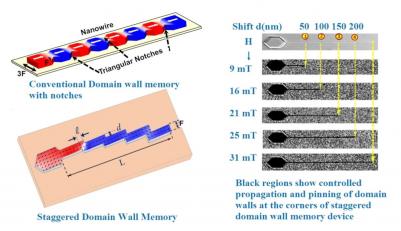Researchers from Sultan Qaboos University in Oman, Johannes Gutenberg-Universität Mainz in Germany and Nanyang Technological University in Singapore have experimentally demonstrated a breakthrough in one of the major problems blocking the adoption of magnetic domain wall memory.
When recording each fresh bit of information onto a racetrack, there is considerable uncertainty about where each magnetic domain starts and ends, and an incorrectly-written bit can easily lead to the corruption of bits. The team, led by Professor Rachid Sbiaa of Sultan Qaboos University, devised a method to overcome this difficulty by using a staggered nanowire (see figure below).
The researchers demonstrated that the corners in a staggered nanowire act as natural resting places for magnetic domain walls, allowing for a clean and predictable separation between different bits. Their experiments show that information recorded in this way can be kept stable for over a year.
Compared to other methods (such as notches), this method enables using narrower nanostrips. This enables more wires to be packed closer, which results in a higher density of nanostrips in an area. The fabrication technique for the staggered devices is also a lot easier than other methods. These results are promising for the future development of high density storage devices based on this principle.
